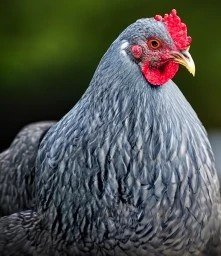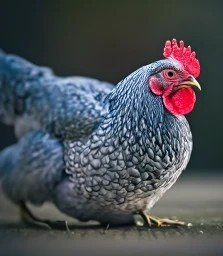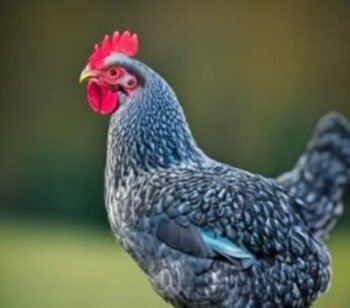Discover everything about Blue Plymouth Rock chickens, their appearance, egg production, boosting egg production, benefits, and cons. Learn why Blue Plymouth Rock chickens are a favorite among poultry enthusiasts.
Introduction
Blue Plymouth Rock chickens, also known affectionately as “Blue Rocks,” are highly valued for their versatility. With their captivating appearance and remarkable egg-laying skills, these birds have captured the hearts of backyard hobbyists and professional farmers alike. They’re cherished for their ability to provide both fresh eggs and, if desired, succulent meat. This combination of beauty and utility has made them a top pick among poultry enthusiasts of all stripes.
Origin of Blue Plymouth Rock Chickens
Blue Plymouth Rock hens originated in the late 19th century in the United States through selective breeding of the Plymouth Rock breed. This variety was developed by crossing breeds like the Barred Plymouth Rock, White Cochin, and Black Java to enhance dual-purpose traits and introduce distinctive blue plumage.
Blue Plymouth Rock Chicken Appearance
Blue Plymouth Rock Chicken Colors
Blue Plymouth Rock hens typically display stunning blue plumage across their entire body. However, their combs are typically red, and their eyes are usually brown. Their toes are commonly yellowish in color.
Blue Plymouth Rock Chicken Size and Weight
Blue Plymouth Rock hens vary in size depending on whether they are hens or roosters. Hens typically weigh between 6.5 to 7.5 pounds, while roosters can reach weights of 7.5 to 9.5 pounds. These weights make Blue Plymouth Rock chickens a sturdy and substantial breed.
Blue Plymouth Rock chicken shape
The Blue Plymouth Rock hen has a sturdy and well-rounded body shape, with a broad chest and ample feathering. They possess a medium-length back and a moderately-sized tail that is carried at a slight angle.

Blue Plymouth Rock Chicken Eggs
Blue Plymouth Rock hens are prolific egg layers, making them a valuable asset for egg production, making them ideal for both culinary and hatching purposes.
Blue Plymouth Rock Chicken Egg Color
Blue Plymouth Rock hen Egg Color is light brown.
Blue Plymouth Rock Chicken Egg Production
Blue Plymouth Rock chicken egg production per year is 200 to 220, which averages to approximately 17 to 18 eggs per month.
10 prolific egg-laying chickens for beginners.
Factors Affecting Blue Plymouth Rock Chicken Egg Production
Several factors influence the egg production of Blue Plymouth Rock hens, including:
Nutrition
Providing them with a well-balanced diet rich in protein, vitamins, and minerals is crucial. Numerous studies, such as those conducted by Smith et al. (2020), emphasize the significant impact of nutrition on egg production in poultry.
Blue Plymouth Rock hens typically receive protein from powdered sources like soybean meal or fish meal. Fresh greens like kale, spinach, and lettuce contribute additional vitamins and minerals, while crushed oyster shells or eggshells serve as calcium sources.
Environment
Creating stress-free environments with optimal lighting and ventilation is crucial for maintaining the health and productivity of Blue Plymouth Rock hens. Research studies, such as those conducted by Johnson et al. (2021), have highlighted the positive impact of environmental conditions on poultry welfare and performance.
Genetics
Choosing high-quality breeding stock with superior egg-laying genetics is essential for maximizing egg production in Blue Plymouth Rock hens. Research studies, such as those conducted by Brown et al. (2022), emphasize the significant role of genetics in poultry performance. When selecting breeding stock, look for signs such as consistent egg production, good body conformation, and robust health.
Also, observe traits like temperament and feather quality, as these can indicate overall vigor and suitability for breeding purposes.
Know about complete House setup of chickens in blue leghorn rooster blog.
Seasonal variation
Egg production in Blue Plymouth Rock hens often varies with the seasons, peaking during the spring and summer months when daylight hours are longer, and temperatures are warmer. Factors like hormonal changes and environmental conditions influence this natural fluctuation.

Blue Plymouth Rock Chicken Benefits
Versatile Utility: Blue Plymouth Rock hens are a smart choice for anyone looking for birds that can do it all. They lay plenty of eggs for your breakfast table and can also provide meat for your meals, helping you save money in the long run.
Egg-cellent Egg Production: These hens are consistent egg layers, which means you’ll always have a fresh supply of eggs on hand. You can save money by producing your own eggs or even make some extra cash by selling them to neighbors or at local markets.
Tough as Nails: Blue Plymouth Rock chickens are tough birds that can handle different weather conditions without getting sick easily. This means fewer trips to the vet and less money spent on treating sick chickens.
Gentle Giants: With their calm and friendly personalities, Blue Plymouth Rock chickens are easy to care for and less likely to cause damage to your property. You’ll spend less on repairs and more time enjoying their company.
Picture-Perfect Poultry: These chickens are not only productive but also beautiful to look at. You can showcase them in your backyard or even sell them to others who admire their appearance, adding a little extra income to your pocket.
Heritage Charm: By raising Blue Plymouth Rock hens, you’re preserving a piece of agricultural history while also tapping into a market for heritage poultry breeds. You can charge premium prices for these birds or their products, making them a valuable asset to your farm.
Eco-Friendly Allies: Let your Blue Plymouth Rock hens help you save money and reduce waste by turning kitchen scraps into nutritious eggs and natural fertilizer. This eco-friendly approach can cut down on feed costs and promote a healthier environment for your farm.
Learn and Grow: Blue Plymouth Rock hens offer valuable lessons in self-sufficiency and responsibility for both children and adults. You’ll learn how to care for animals, manage a small business, and make the most of your resources while enjoying the financial benefits of a successful poultry venture.

Blue Plymouth Rock Chicken Cons
Challenges of Raising Blue Plymouth Rock hens
Broodiness: Blue Plymouth Rock hens can become broody, disrupting egg production.
Space Requirements: These larger chickens need ample space to thrive, which may be a challenge in smaller coops.
High Feed Consumption: Due to their size, Blue Plymouth Rocks eat a lot, leading to higher feed costs.
Molt Periods: Molting can disrupt egg production and require extra care from owners.
Susceptibility to Predators: Despite their hardiness, Blue Plymouth Rocks are still vulnerable to predators and require secure housing.
Know about Common mortality ways and common predators of Chickens.
Conclusion:
In conclusion, Blue Plymouth Rock chickens present a blend of advantages and hurdles. Despite their inclination towards broodiness and the necessity for generous space, these birds can be lucrative assets to your flock. By addressing their requirements and offering adequate care, owners can reap the rewards of a consistent egg and meat supply while bolstering their financial standing. Whether you’re a newcomer or seasoned farmer, Blue Plymouth Rocks hold the potential to enhance your homestead with their gentle disposition and picturesque allure, all while contributing to your bottom line.
What color eggs do Blue Plymouth Rock chickens lay?
Blue Plymouth Rock chickens lay eggs with a light brown color.
What is a Blue Plymouth Rock chicken?
A Blue Plymouth Rock chicken is a breed known for its blue plumage, dual-purpose capabilities, and friendly demeanor.
Are Blue Plymouth Rock chickens good layers?
Yes, Blue Plymouth Rock chickens are excellent layers, with hens producing an average of 200 to 220 eggs per year.
What is the lifespan of a Blue Plymouth Rock chicken?
Blue Plymouth Rock chickens typically live for 6 to 8 years, though with proper care, they can live longer.
How many eggs do Blue Plymouth Rock chickens lay?
Blue Plymouth Rock chickens can lay approximately 200 to 220 eggs per year, depending on various factors such as nutrition, environment, and genetics.


Как избежать дубликатов номеров на документах, изучите прямо сейчас.
Эффективные способы борьбы с дубликатами номеров, воплотите в жизнь наши советы.
Как обезопасить свои номера от дубликатов, предлагаем изучить.
Опасность дубликатов номеров и как им избежать, не откладывайте на потом, проверьте немедленно.
Советы по правильной нумерации для избежания дубликатов, используйте на деле наши рекомендации.
Почему важно не допускать дубликатов номеров, советуем прочитать.
Эффективное руководство по борьбе с дубликатами номеров, попробуйте эти методы.
Признаки того, что номера не уникальны, примените эти советы уже сегодня.
Что делать, если обнаружены дубликаты, попробуйте на практике.
изготовление гос номеров дубликат https://dublikat-nomerov777.ru/ .
Your posts in this blog really shine! Glad to gain some new insights, which I happen to also cover on my page. Feel free to visit my webpage Article Home about SEO and any tip from you will be much apreciated.
Hello there, just become aware of your blog via Google, and found that it’s really informative. I’m going to be careful for brussels. I will be grateful should you proceed this in future. Numerous folks shall be benefited from your writing. Cheers!
Thank you for your blog post. Velupe and I happen to be saving for our new ebook on this topic and your writing has made us to save the money. Your notions really answered all our concerns. In fact, over what we had acknowledged prior to when we came across your amazing blog. I actually no longer nurture doubts along with a troubled mind because you truly attended to all of our needs right here. Thanks
I would point out that we website visitors actually are unequivocally lucky to exist in a useful website with so many wonderful people with very helpful concepts.
Its like you read my mind! You appear to know a lot about this, like you wrote the book in it or something. I think that you can do with a few pics to drive the message home a bit, but instead of that, this is excellent blog. A fantastic read. I will definitely be back.
Hi are using WordPress for your blog platform? I’m new to the blog world but I’m trying to get started and set up my own. Do you need any coding knowledge to make your own blog? Any help would be greatly appreciated!
Thanks for this web site post and discussing your own results together with us. Very well performed! I think a lot of people find it difficult to understand paying attention to several controversial things associated with this topic, but your own results talk for themselves. I think a number of additional takeaways are the importance of following each of the suggestions you presented in this article and being prepared to be ultra distinct about which one could really work for you greatest. Nice job.
certainly like your web-site but you have to check the spelling on quite a few of your posts. Many of them are rife with spelling problems and I in finding it very bothersome to inform the truth however I will definitely come again again.
I believe, to make the agents with references to: generic people will want a feeling of responsibility; middle-level workforce have each of those feelings of obligations but probably self-motivated; and additionally middle management of one’s businesses important might be the acknowledgement concerning numbers, as well as corporation obtain together with the advancement of employment center.